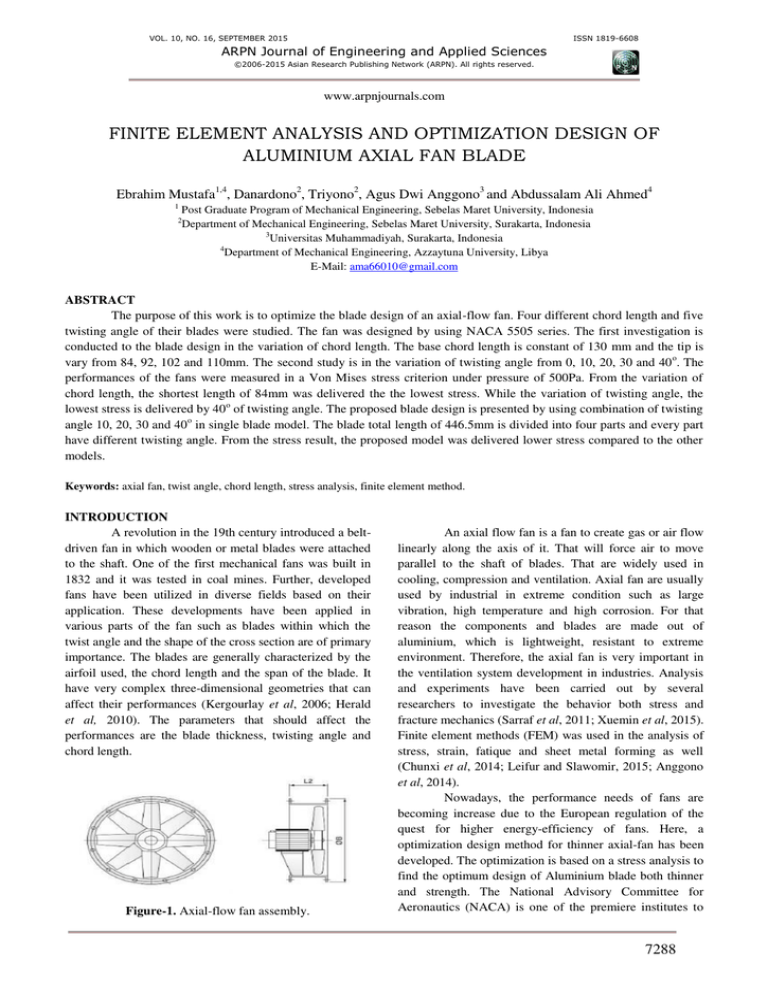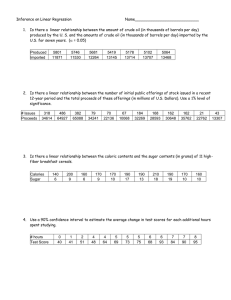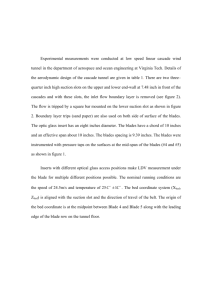
VOL. 10, NO. 16, SEPTEMBER 2015
ISSN 1819-6608
ARPN Journal of Engineering and Applied Sciences
©2006-2015 Asian Research Publishing Network (ARPN). All rights reserved.
www.arpnjournals.com
FINITE ELEMENT ANALYSIS AND OPTIMIZATION DESIGN OF
ALUMINIUM AXIAL FAN BLADE
Ebrahim Mustafa1,4, Danardono2, Triyono2, Agus Dwi Anggono3 and Abdussalam Ali Ahmed4
1
Post Graduate Program of Mechanical Engineering, Sebelas Maret University, Indonesia
Department of Mechanical Engineering, Sebelas Maret University, Surakarta, Indonesia
3
Universitas Muhammadiyah, Surakarta, Indonesia
4
Department of Mechanical Engineering, Azzaytuna University, Libya
E-Mail: ama66010@gmail.com
2
ABSTRACT
The purpose of this work is to optimize the blade design of an axial-flow fan. Four different chord length and five
twisting angle of their blades were studied. The fan was designed by using NACA 5505 series. The first investigation is
conducted to the blade design in the variation of chord length. The base chord length is constant of 130 mm and the tip is
vary from 84, 92, 102 and 110mm. The second study is in the variation of twisting angle from 0, 10, 20, 30 and 40 o. The
performances of the fans were measured in a Von Mises stress criterion under pressure of 500Pa. From the variation of
chord length, the shortest length of 84mm was delivered the the lowest stress. While the variation of twisting angle, the
lowest stress is delivered by 40o of twisting angle. The proposed blade design is presented by using combination of twisting
angle 10, 20, 30 and 40o in single blade model. The blade total length of 446.5mm is divided into four parts and every part
have different twisting angle. From the stress result, the proposed model was delivered lower stress compared to the other
models.
Keywords: axial fan, twist angle, chord length, stress analysis, finite element method.
INTRODUCTION
A revolution in the 19th century introduced a beltdriven fan in which wooden or metal blades were attached
to the shaft. One of the first mechanical fans was built in
1832 and it was tested in coal mines. Further, developed
fans have been utilized in diverse fields based on their
application. These developments have been applied in
various parts of the fan such as blades within which the
twist angle and the shape of the cross section are of primary
importance. The blades are generally characterized by the
airfoil used, the chord length and the span of the blade. It
have very complex three-dimensional geometries that can
affect their performances (Kergourlay et al, 2006; Herald
et al, 2010). The parameters that should affect the
performances are the blade thickness, twisting angle and
chord length.
Figure-1. Axial-flow fan assembly.
An axial flow fan is a fan to create gas or air flow
linearly along the axis of it. That will force air to move
parallel to the shaft of blades. That are widely used in
cooling, compression and ventilation. Axial fan are usually
used by industrial in extreme condition such as large
vibration, high temperature and high corrosion. For that
reason the components and blades are made out of
aluminium, which is lightweight, resistant to extreme
environment. Therefore, the axial fan is very important in
the ventilation system development in industries. Analysis
and experiments have been carried out by several
researchers to investigate the behavior both stress and
fracture mechanics (Sarraf et al, 2011; Xuemin et al, 2015).
Finite element methods (FEM) was used in the analysis of
stress, strain, fatique and sheet metal forming as well
(Chunxi et al, 2014; Leifur and Slawomir, 2015; Anggono
et al, 2014).
Nowadays, the performance needs of fans are
becoming increase due to the European regulation of the
quest for higher energy-efficiency of fans. Here, a
optimization design method for thinner axial-fan has been
developed. The optimization is based on a stress analysis to
find the optimum design of Aluminium blade both thinner
and strength. The National Advisory Committee for
Aeronautics (NACA) is one of the premiere institutes to
7288
VOL. 10, NO. 16, SEPTEMBER 2015
ISSN 1819-6608
ARPN Journal of Engineering and Applied Sciences
©2006-2015 Asian Research Publishing Network (ARPN). All rights reserved.
www.arpnjournals.com
develop airfoils. The airfoil developed by NACA are
characterized into series (Anderson, 2001).NACA 5505
was selected in the design for thin and lightweight blade.
P'xl
Pl
Pa
MECHANICAL ANALYSIS
In the axial-flow fan, the blades on the airflow to
realise the energy transmission, therefore it can produce
the pressure and make the air flow at the same time.
Figure-1 gives illustration of axial-flow fan. The motor has
diameter of D. Airflow enters into the blades at the
absolute velocity of C1 and leaves st that of C2. Assuming
tha C1 is in the axial direction, C1x = 0, we get:
∆
=
−
=
(1)
The inlet and outlet motion parameter of the
airflow is:
� =√
�
=
�
�
+ (� −
� /�
�2�
= �−
)
/�
(2)
Airflow exerts on the blade in two components,
the lift Py1 normal to the Wm and the drag P'x1 parallel to
the Wm respectively
R
Py
ε+βm
Fu
Pu
θ
C2
β
Cu
u
Figure-2. Force diagram of blade element.
MATERIALS AND METHODS
In this study, a blade of NACA 5505 airfoil is
analyzed for the Von Mises stress distribution and how it
varies as a function chord length and twist degree. The
blade is made of aluminium. It has a length of 446.5mm
and has a cross sectional profile of NACA 5505 airfoil.
The primary chord length before variation was 130mm.
Later, it was varied till 84mm. The twist angle was
gradually changed in increments from 0 deg to 40 deg.
The blade is made of Aluminium6061-T91with
the Young's modulus of 6.9E9 Pa and Poisson ratio of
0.33.The pressure load is applied to the lower surface of
the blade
DESIGN METHODOLOGY
�
�′
=
=
∆ �
′
(3)
∆ �
(4)
where,
∆r = particular of radius
Cy1 = Cy1(α)
′
=
+ .
8
+
�
. 8
INFLUENCE OF CHORD LENGTH
In this analysis, the investigation is conducted in
changing the chord length changes the Von Mises stress
over the wing. The base chord length is constant of
130mm. The tip chord length was chosen to be 110mm.
Then the tip chord length is changed gradually to a value
of 102, 92 and 84 mm. Figure-3. gives illustration of
different tip chord length that will be used in the analysis.
−
The reactive force Rx1 subjected on the blade isRx1
= -P'x1
From the Figure-2, if the blade moves uniformly,
the driving force to let the blades rotate is
Figure-3. Various chord lengths of NACA5505.
�� = �� = � �
�+
=
∆ �
��
�+��
� ��
(5)
INFLUENCE OF TWISTING ANGLE
Blade angle is defined as the angle between the
chord of a propeller or rotor blade and a plane normal to
the axis of rotation. Its amount changes along the span and
it declines from root to tip because of the blade twist angle.
7289
VOL. 10, NO. 16, SEPTEMBER 2015
ISSN 1819-6608
ARPN Journal of Engineering and Applied Sciences
©2006-2015 Asian Research Publishing Network (ARPN). All rights reserved.
www.arpnjournals.com
Figure-4. Airfoil shape of cross section with diverse
Twist angles.
From the variation of tip chord length and
twisting angle, there are 4 types models of different tip
chord length. Then every models have variation 5 types of
different twisting angle. So, in the analysis there are 20
different models.
stress on blade. The analysis is conducted by using the
blade model without twisting angle or the twisting angle is
zero. The highest stress of 1.68 x 10 7 Pa is delivered from
the tip of chord length 110 mm as shown in the Figure-7.
While the shortest tip of chord length 84 mm was
delivered the the lowest stress 1.19 x 107 Pa. The
phenomenon can be happen due to the acting force is
higher in the higher surface area. From the definition,
pressure is force per unit area. When the pressure is
constant, the force is proportional to the area. Based on the
investigation of the influence of chord length, the best
model is the lowest stress. That is the blade model with the
tip of chord length 84 mm.
Von Mises Stress (Pa)
In order to promote the efficiency, the airflow of an axial
flow fan should be consistently spread over the working
face of the fan wheel. In other words, the axial air velocity
should be the same from hub to tip. On the other hand, the
velocity of rotating blade is not evenly distributed. Its
velocity is low near the centre and escalates towards the
tip. This variation of velocity should be compensated by a
twist angle of the blade, which is a larger blade angle near
the centre and smaller blade angle toward the tip. In the
analysis, the variation of twist angle are 0o, 10o, 20o, 30o
and 40o as illustrated in the Figure 4.
1,80E+07
1,70E+07
1,60E+07
1,50E+07
1,40E+07
1,30E+07
1,20E+07
1,10E+07
1,00E+07
80
90
100
110
120
tip Chord length (mm)
Figure-6. Influenced of tip chord length in the stress
generation.
THE PROPOSED MODEL
According to the variation of twisting angle and
tip chord length, the new model of blade is then proposed.
The model will use all twisting angle of 0 o, 10o, 20o, 30o
and 40o in a blade design as described in Figure-5. Then
the model is varied into different tip chord length. The
other properties of
Aluminium 6 series.
Figure-7. Stress distribution of NACA 5505, tip chord
length 110 mm.
L1
L2
L3
L4
40
30o
20o
10
0o
Figure-5. The proposed model use different twisting angle
in four span.
RESULTS AND DISCUSSIONS
Figure-6. shows the maximum stress in every tip
of chord length. From the figure, it can be said that
increasing tip of chord length will increase the maximum
The investigation of the blade is continued to the
influence of twisting angle in every variation of chord
length. Starting from the tip of chord length 84 mm, the
result is described in the Figure-8. The highest stress is
1.19 x 107 Pa resulting from the twisting angle of 0 o. The
stress is then decrease related to the increasing of twisting
angle 10o, 20o, 30o and 40o . The stresses are 1.17 x 107,
1.09 x 107, 1.05 x 107 and 1.02 x 107 Pa respectively.
The lowest stress is 1.02 x 107 Pa delivered from
the twisting angle 40o as seen in the Figure-8. It was seen
that the overall stress results of chord length 84 mm is
lower then the others model of longer chord length in
7290
VOL. 10, NO. 16, SEPTEMBER 2015
ISSN 1819-6608
ARPN Journal of Engineering and Applied Sciences
©2006-2015 Asian Research Publishing Network (ARPN). All rights reserved.
www.arpnjournals.com
it is clearly seen that the lowest stress of 7.78 x 106 Pa was
delivered by the model with 84 mm chord length as seen in
the Figure-11. The figure is illustrated the stress
distribution of blade model.
Von Mises Stress (Pa)
every twisting angle of 0o, 10o, 20o, 30o and 40o. The chord
length 92 and 110 mm were delivered stress in a same
trend as shown in the Figure-8.
The investigation is then continued to plot the
maximum stress in every twisting angle of the different
chord length model as described in the Figure-9. From the
figure, it is clearly seen that the highest stress was
delivered by twisting angle 0o with 110 mm chord length.
While the lowest stress was delivered by 40o twisting
angle with 84 chord length. According to the analysis of
the influence of twisting angle, the suggested model is 40o
of twisting angle.
9,20E+06
9,00E+06
8,80E+06
8,60E+06
8,40E+06
8,20E+06
8,00E+06
7,80E+06
7,60E+06
Von Mises Stress (Pa)
80
1,80E+07
1,70E+07
1,60E+07
1,50E+07
1,40E+07
1,30E+07
1,20E+07
1,10E+07
1,00E+07
9,00E+06
90
100
110
120
Tip Chord length (mm)
Figure-10. Maximum stress of proposed model in
variation of tip chord length.
Chord 110
Chord 102
Chord 92
Chord 84
0
20
40
60
Tip of twisting angle (deg)
Figure-8. Influenced of twisting angle of stress generation
in the variation of tip chord length.
Von Mises Stress (Pa)
Figure-11. Stress distribution of proposed model of
NACA 5505, tip chord length 84 mm.
1,80E+07
1,70E+07
1,60E+07
1,50E+07
1,40E+07
1,30E+07
1,20E+07
1,10E+07
1,00E+07
Twist Angle 0
Twist Angle 10
Twist Angle 20
Twist Angle 30
Twist Angle 40
80
90
100
110
120
tip Chord length (mm)
Figure-9. Maximum stress in every twisting angle.
RESULTS OF PROPOSED MODEL
The proposed model of fan blade is design based
on the investigation of the influence of chord length and
twisting angle related to generate stress in the blade. The
model is then analyzed by using finite element method of
Abaqus Student Edition. The analysis condition is same as
the previous analysis, therefore the result is able to
compare each others.
The proposed model is varied in chord length to
make sure the lowest stress is delivered by the lower chord
length as mention before. Figure-10 described the maximm
stress in different model of chord length. From the figure,
While the highest stress of 8.99 x 10 6 Pa as
plotted in Figure10 and illustrated in Figure-12 is delivered
by model with 110 mm chord length. Figure-12 shows the
stress distribution of the model and give the location of
highest stress in the blade model. All maximum stress
location is in the area of the base because that area is near
to the location of constraint or clamp position. The stress
concentration will be rise on the area of clamp but for the
proposed model, the maximum stress is lower than the
yield stress of the material.
Figure-12. Stress distribution of proposed model of
NACA 5505, tipchord length 110 mm.
7291
VOL. 10, NO. 16, SEPTEMBER 2015
ISSN 1819-6608
ARPN Journal of Engineering and Applied Sciences
©2006-2015 Asian Research Publishing Network (ARPN). All rights reserved.
www.arpnjournals.com
CONCLUSIONS
The stress analysis of the Aluminium fan blade
has successfully conducted by using finite element
method. The lower chord length of the fan blade has given
lower stress in every condition of twisting angle. While the
twisting angle of 40o has also shown the lowest stress.
The proposed model has successfully developed
using 84 mm chord length and distributed twisting angle
from 0o, 10o, 20o, 30o and 40o in one blade. The stress
analysis of the proposed model has successfully shown
that the maximum stress is lower than the other models.
Based on the stress analysis, the proposed model has
delivered the best results and able to implement for axial
fan blade.
effect on performance and dynamics of an axial flow
fan, Energy. 82: 556-569.
REFERENCES
[1] Anderson J. D. 2001. Fundamentals of aerodynamics McGraw - Hill, New York. Vol. 2.
[2] Anggono A.D., Riyadi T.W.B. 2015. Finite element
simulation of the drawability of tailor-welded blank.
Applied Mechanics and Materials. 660: 3-7.
[3] Chunxi L., Xinying L., Pengmin L., Xuemin Y. 2014.
Numerical investigation of impeller trimming effect
on performance of an axial flow fan, Energy 75: 534548.
[4] Hurault J., Kouidri S., Bakir F., Rey R. 2010.
Experimental and numerical analysis ofthe sweep
effect on three-dimensional flow downstream of axial
flow fans. Flow Measurement and Instrumentation.
21: 155-165.
[5] Kergourlay G., Kouidri S., Rankin G.W., Rey R.
2006. Experimental investigation of the 3d unsteady
flow field downstream of axial fans. Flow
Measurement and Instrumentation. 17: 303-314.
[6] Leifur L., Slawomir K. 2015. Simulation-driven
design of low-speed wind tunnel contraction. Journal
of Computational Science 7: 1-12.
[7] Sarraf C., Nouri H., Ravelet F., Bakir F. 2011.
Experimental study of blade thickness effects on the
overall and local performances of a Controlled Vortex
Designed axial-flow fan. Experimental Thermal and
Fluid Science. 35: 684-693.
[8] Xuemin Y., Pengmin L., Chunxi L., Xueliang D.
2015. Numerical investigation of blade tip grooving
7292



